Home Finance - Home.Finance.Ua

Dear Habra-people, in this post I would like to talk about the online system for conducting home accounting " Home Finance - Home.Finance.Ua "
I will divide my post into two parts. The first one will be more home-accounting, where I will tell you what interesting and useful the system can do. And the second is technical, in which I will try to reveal some of its architectural features. If there are a lot of letters for someone, there is such a big button on the main page “ Test the HOME FINANCE system ”, which leads to an account filled with real data.
Home Accounting Part
Home Finance is an online system for conducting home accounting, accounting for personal finances, and planning a family budget. Structurally, the management of home accounting in Home Finance can be divided into accounting , planning and analysis . And so, everything in order.
Accounting
All financial transactions in Home Finance are simplified to expenses , income (which determine the exchange of budget money with the outside world) and transfers to accounts (intra-budget transfer of money). With these three simple and intuitive operations, it is easy to describe any financial somersault: taking a loan, borrowing money for a short or long term, exchanging currency, saving money, returning money for goods returned to the store, reimbursement of office expenses, etc. Some schemes (in in particular, various options for accounting for debts) are described here .
You can make the next operation directly or by SMS, sending a set up according to certain rulesa text message to a regular (in the sense of tariffing SMS messages) MTS number. By the way, just recently, one of our users wrote a small Android application in which you can conveniently create and store operations and then send them to the server with a message compiled automatically.
Planning
Planning in Home Finance consists of three different ... “plans."
You can plan each individual financial transaction . You can enter in advance the known operations of the coming month and then, as the corresponding date approaches, simply “confirm” them. Thus, the “planned” operation will turn into “perfect” and will begin to go through all financial statements. If not, it will become “expired” and will be an eyesore in the eye until it is deleted or confirmed. Maniacs who like to create many “planned” operations ahead of time can use the cloning of operations with an indication of the periodicity algorithm (every weekday, every weekend; the same day of every week, month).
Budget planning- the second type of planning. It consists in setting planned values for each separate category of expenses and incomes. For those who are just starting to plan, it’s convenient to start with some conditional values. And those who notice regularities from month to month can use “Planning with compensation” - this is an opportunity to change the plan for one category both due to the reverse change of plans for other (all or specified) categories, and due to a change in the total amount of planned expenses or income .
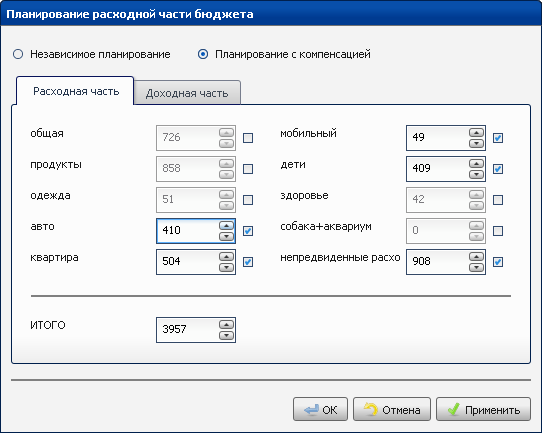
Financial goals - the last type of planning that allows you to plan balances. Accumulating money for a vacation, an expensive purchase, just deferring a certain amount of savings to the appointed date - this is a financial goal, so to speak, to borrow funds in a certain amount, that is, to get the balance.
Analysis
To analyze your financial condition, control key financial indicators in Home Finance, there are many financial reports.
The most general and opening upon entering the system is the report “Results of the reporting period” . Here you can create your own widgets to display indicators of interest to the user: the amount of expenses (income) for the specified categories, the amount of balances on the given accounts. If you choose the right financial indicators for yourself, this report will be sufficient in most cases, working with the system.

“Spending table” shows all operations for the active budget period. It can be sorted by any column, edited in cells, the total amount of the listed operations is displayed in the table footer.
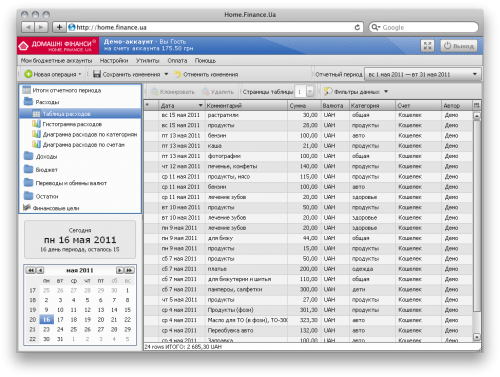
bar chart"Expenses by days / periods" shows the amount of expenses on the corresponding days. If you have planned and / or expired operations, their amounts will be visible on this histogram in a different color.

Pie charts “Amounts of expenses by categories” and “Amounts of expenses by accounts” allow you to compare expenses for different categories or from different accounts.
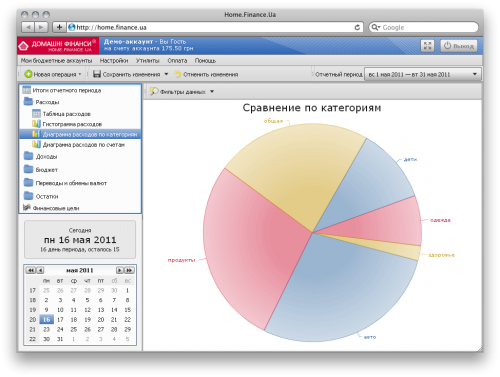
It is worth noting the wide possibilities of filtering operations. You can filter the investigated set of operations of the active period by category, account, currency, date, type or comment fragment. In this case, both in the table and in the diagrams you will see reports compiled only for the operations selected by the filter. So, for example, on the histogram, you can get the daily expenses only for the Transport category, or you can compare the costs for the two categories of Products and Entertainment on a pie chart only.

To control the implementation of the expenditure and income budgets, two tabular reports and one graphic are used (on it you will see the planned and actual amounts for both separate categories of expenses and revenues, and in general the plans and facts of the expenditure and income parts of the budget).
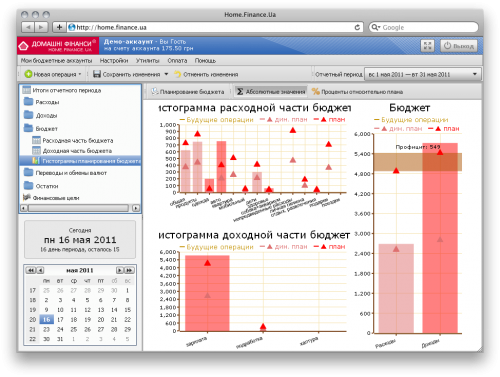
Complex chart“Dynamics of balances by days / periods” shows a linear graph of changes in account balances and the amount of expenses-deductions and income-accruals on accounts. You can select the accounts for analysis and the currency of the balances you are interested in. In addition, you can see the dynamics of changes in balances in all currencies in the equivalent of the main currency of the account (taking into account the real exchange rate of cash currencies on the corresponding dates).
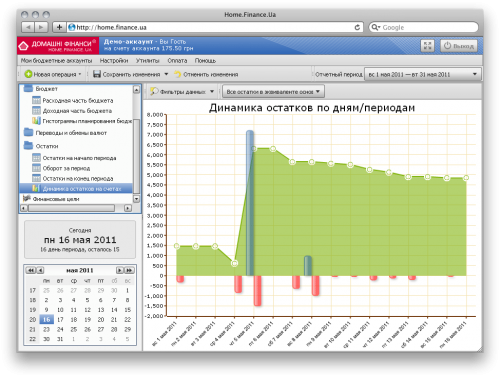
The “Financial Goals” report shows histograms that are separate for each financial goal: the percentage of the accumulated balance of the planned and the percentage of elapsed time from the allotted time.

There is a so-called multiplayer in Home Finances- The ability to maintain several independent budgets by one user and access of several users to one budget account with different levels of rights. Since the system is focused on home accounting, access rights levels are quite characteristic:
- Guest can only view reports
- The user can watch and make new operations, but without the ability to edit or delete them
- An editor is a user who can edit and delete his operations.
- An experienced editor can edit and delete any operations of a budget account.
- Admin has access to account settings
I would also like to say about budget grids . In Home Finances, you can use the weekly , monthly (with the choice of the day of the month, which will be considered the day the new budget period begins) and quarterly budget grids. At the same time, you can change the type of grid at any time (for example, you always work with the “monthly” grid, but decided to track some indicator on the quarterly). This does not affect the financial history, all data is restructured on the fly.
If you need to track indicators (dynamics of balances, expenses by category) not every day within the same budget period, but from period to period - use the " All periods " mode". Corresponding reports are independently converted to the desired time grid.
If you are actively using different types of planning, you will need such a feature as " Date of relevance of accounting . " This is practically a time machine that allows you to move to the past and future and see your financial indicators in that form what they were or will be in. Transferred to the future - and received:
- access to “future” budget periods
- all planned operations that have turned out to be perfect in the past regarding the new “today” will be completed according to financial statements and will be available for any analysis
In addition to such global pieces, there are many small convenient features: entering checks , “Notes” , exporting to csv , calculator , etc.
The Home Finance system is partially paid . After a trial period of 45 days, you can continue to use the full range of functionality (except multiplayer), but with a limitation on the number of transactions and the frequency of access to the system. This point is described in more detail here . I can only say that the fee for work without restrictions is 0.50 UAH per day .
I will be happy to answer all questions about functionality in the comments. And now I will tell a little about the architecture of the system.
Technical part
Architecturally Home Finance consists of three elements. The main one is the client js application. It is written on the wonderful qsoxoo js framework . The data comes into the application in raw form, all calculations and reporting are done in the browser. OpenFlashChart is used to display charts and graphs .
The second most important part is the server with PHP + MySQL, with which the client communicates. The SMS gateway is separate and works with the server via http.
All local changes in the client application (created, edited and deleted operations, changed settings) require forced saving to the server(triggered by user action or automatically). Thus, once the downloaded application can for a long time (while the html-page of the application is open) do not require access to the server and practically work offline. Communication will be required either when the changes are saved, or to cancel the changes, or when changing the active budget period. This requires a bit of excess traffic during a cold start, but on the other hand saves it later and gives some autonomy in work.
Well, the third part is a wrapper, an external site with different beauties, legal information, documentation and a support forum . It uses Kohana3 and jQuery .
In the comments I will try to answer questions and constructive criticism.
